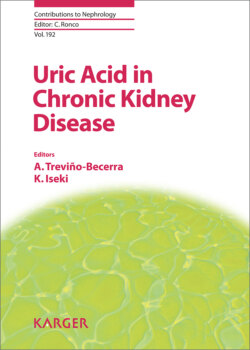Читать книгу Uric Acid in Chronic Kidney Disease - Группа авторов - Страница 36
На сайте Литреса книга снята с продажи.
Damaging Intracellular Pathways Induced by Uric Acid
ОглавлениеThe common association between uric acid and tissue damage is by means of its extracellular precipitation, similar to what occurs in joints in gout. However, the studies conducted involving mild hyperuricemic animals showed that the rise in intracellular concentrations of UA initiates a cascade of pathways that lead to hypertension, kidney damage, and metabolic alterations.
Soluble UA enters into cells through transporters including URAT1 and organic anion transporters such as OAT 1, 2, 3, 4, and 10. Inhibition of UA transport with probenecid or benziodarone is capable of blocking its toxic effects in vitro, in vivo, as well as in clinical studies [20, 21]. In addition, in several cell types, there is evidence of bidirectional transport of UA [20]. Interestingly, the expression and function (intake or secretion) of the different UA transporters were found to vary according to the organ and species [22], and there is also evidence of interaction among the various UA transporters to regulate systemic UA concentrations [23]. On the other hand, intracellular concentrations of UA may also increase by stimulating its synthesis by xanthine oxidase. Some enzymatic defects resulting from genetic mutations, such as in Lesch-Nyman syndrome, result in UA overproduction. However, environmental factors play a major role; thus, diets rich in fructose or purines, as well as lead exposure can contribute to increasing the synthesis of UA.
Once UA intracellular concentrations increase, via cellular uptake or increased synthesis, the studies suggest that the first step in the deleterious path is the increase in oxidative stress by stimulating NADPH oxidase activity. This primary effect seems to be preserved among several cell types as it has been found in vascular smooth muscle cells, endothelial cells, adipocytes, pancreatic cells, hepatocytes, cardiac fibroblasts, renal tubule, and mesangial cells [24–28]. The increase in intracellular oxidative stress stimulates protein kinases (MAPK’s, ERK 1/2), proinflammatory transcription factors (NF-kB), and proliferative factors (PDGF, TGF-b) [24–28]. Stimulation of such pathways then induces the synthesis of vasoconstrictors (Angiotensin II, endothelin-1, thromboxane), proinflammatory factors (MCP-1, PCR), and NLRP3 inflammasome activation with IL-1β secretion. In addition, mitochondrial and endoplasmic reticulum alterations have been described in several cell types [24–28]. UA also induces endothelial dysfunction by reducing NO bioavailability and endothelial cells senescence and apoptosis. In summary, UA activation of damaging pathways has different outcomes that depend on the cell type; thus, in renal tubular and mesangial cells, inflammation and dysfunction are induced, in VSMC, inflammation and proliferation are induced, in endothelial cells, dysfunction and senescence are induced, in hepatocytes, the oxidation of fatty acids is blocked and fatty acid synthesis is promoted, in adipocytes, adiponectin synthesis is inhibited, in pancreatic cells, insulin production is inhibited, and in cardiac fibroblasts, the synthesis of profibrotic molecules is induced [24–28].
On the other hand, extracellular UA can also induce damage. UA solubility is low in physiological fluids, ∼6.8–7.0 mg/dL. Individuals with higher concentrations of UA have a supersaturated plasma uric acid concentration, and this condition predisposes to the formation of monosodium urate crystals, although others factors also participate in the initiation of crystallization, since not all hyperuricemic patients develop gout [29]. In the kidney, increased fractional excretion of UA in association with an acidic urine leads to the formation of UA crystals, such as is the case of tumor lysis syndrome, and more recently, this mechanism has also been described as a potential causal factor for the nephropathy from nontraditional causes in Central America, named Mesoamerican Nephropathy [30]. Uric acid crystal-mediated damage includes the activation of tissue macrophages with increased secretion of IL-1β and neutrophil influx [29]. Upon infiltration, neutrophils are further activated by the crystals, producing additional inflammatory mediators [29]. When phagocytized, urate crystals activate the NLRP3 inflammasome, which induces maturation and secretion of IL-1β, and a downstream cascade of inflammation mediated by cytokines, prostanoids, and other molecules [31]. This process would be associated with a couple of kidney diseases, including Mesoamerican Nephropathy and IgA nephropathy. In these diseases, hyperuricemia and uricosuria were found to be related to interstitial fibrosis and tubular atrophy respectively [30, 32–34].
Interestingly, extracellular UA can also function as an antioxidant and exerts neuroprotective effects in acute brain ischemia as well as in other CNS diseases [35]. Thus, regional cellular phenotypes can respond differently to UA.
